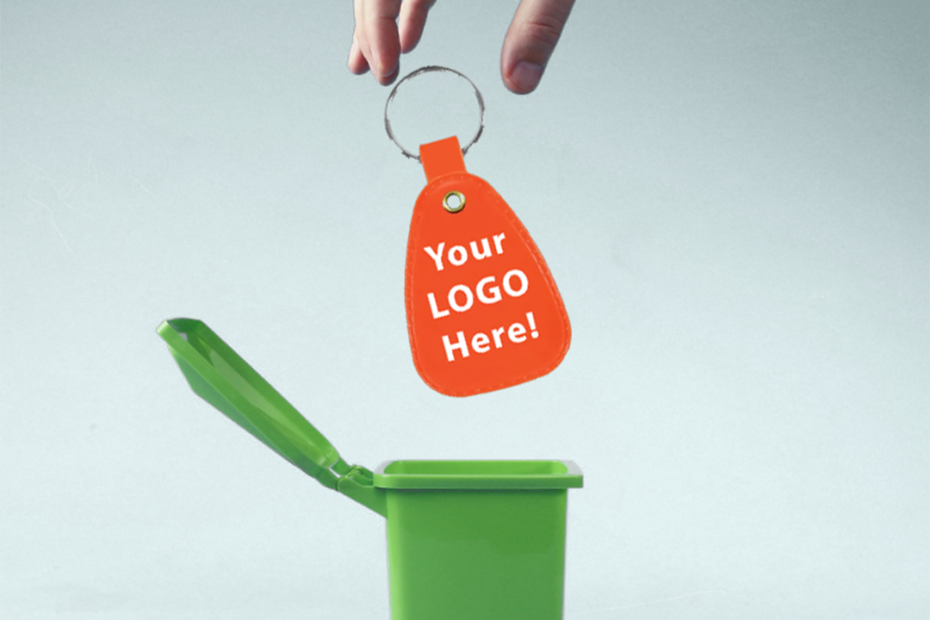One of my favorite customers is a non-profit that helps kids, who I will call BBR. Recently, my contact there called me up and said, “we need 1000 one-dollar giveaways for a neighborhood street fair.” And I asked, “why?”
I can’t tell you how many times I’ve had some version of this conversation. I push back, because I don’t want to put more junk in landfills or feed the plastic floating ocean island monster. Also, I don’t want my customers to spend money to hurt their own reputations.
That’s right, I said it. Giving out 1000 cheap giveaways was potentially going to devalue BBR’s reputation. I call these little junk swag items “de-motional items,” because that’s often what they do to your brand reputation.
There’s a lot of momentum behind these assumptions:
- I have to get my message to as many people as possible
- My budget is limited, so I’m forced to go with something cheap
- Everybody gives out stuff like this
- Something is better than nothing
But something that’s junk is actually not better than nothing. At best, it’s a waste of your limited funds. At worst, it connects your brand with ideas like junk/cheap/meaningless in the minds of your audience. Why pay to de-promote your brand?
You might be thinking, “I like having cheap little swag items like pens, I find them useful.” Sure, I have a few cheap pens with logos in a mug on my desk. And I use them. But the only time I pay attention to the logo is when they stop working, as I toss them in the trash in frustration. Not exactly the kind of connection I want my brand to have with our customers…
I wanted to help BBR while respecting their budget.
So, I asked more “why” questions. Why are you hosting a booth at this street fair? What are your goals? Who do you want to connect with, and with what objective?
Any form of marketing aims to change the attitude or behavior of the audience. Ask yourself this question before you dive into any marketing endeavor: who is my ideal customer/client/fan, and how do I want to change their attitude or behavior?
Attitude can mean things like:
- awareness
- school spirit
- loyalty
- respect
- sense of connection / values alignment
Behavior can be things like:
- buying more of your best product
- recommending you to others
- attending more school events
- learning more about you
- donating to your cause
This outcome, a change in attitude and behavior, makes up the benefit you are paying for when you market. It’s the same whether you’re using google ads, mailers, or promotional items.
Once you know your (specific) audience, and know your (specific, focused) desired outcome, then you can carefully choose the right marketing vehicle that’s a match. Sometimes, that means a thoughtfully chosen physical item decorated with your logo.
Back to BBR. It turns out they had three prioritized goals for this event. By far the biggest was a “long-shot” goal – engage with one potential high-level donor and convert them into a supporter of BBR. Number two was engaging with a dozen or so mid-tier donors who might even be moved to give their first donation while in the booth. Finally, they hoped to create a positive first impression in the minds of as many of the fair guests as possible.
I suggested focusing their promo budget on priorities one and two. There’s a reason they were number one and two. They mattered more. Success in these would benefit BBR so much more than success in priority three.
Instead of 1000 $1 items that would be either forgotten or trashed within a week, I suggested ordering 40 of something special, like a $25 vacuum-sealed bottle that might become a potential donor’s new favorite water bottle that she uses daily.
When you foster a cycle of gratitude, magic can happen.

Here’s how the story might go: Your potential donor (or customer) is a little surprised at the high quality item she’s being given. She brings it to the gym the next day, and her friend compliments her on it. “I know, it’s my new favorite bottle!” Pointing at the logo she continues, “I got it from this really cool nonprofit.”
She now associates her bottle with BBR, and every time she appreciates it, she feels gratitude to BBR. She gets compliments from her friends on the bottle, once again thanks to BBR. Sometimes she’ll mention BBR during all of this, which gives her a greater sense of connection to BBR. Sometimes she’s even giving little testimonials about BBR to her friends. Being a fan of the bottle facilitates her becoming a fan of BBR.
If you’re going to spend $1000 on promoting your brand, would you rather buy 40 heartfelt testimonials from an engaged supporter, or one thousand trips to the trash bin, where your logo is featured among banana peels and wadded up Amazon bubble wrap?
Not to mention, which one feels like a better gift to the world?
Eventually, BBR invested in some high-quality items they hope will end up on the desks and in the hands of executive level donors.
Actually, they are opting for a pen after all, but it’s a very nice pen that slides into a fitted slot on the quality, embossed leather journal that’s the core of the gift. And that’s what it will feel like to their donors – a top-notch gift. Gifts inspire gratitude and connection. Chotchkes inspire…nothing.
In the eyes of your audience, you are what you give.
If you enjoyed this blog, please leave a comment or follow me on LinkedIn.

The articles you write help me a lot and I like the topic
Comments are closed.